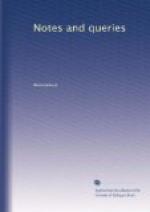P.H.F.
* * * * *
QUERIES.
“ORKNEYINGA SAGA.”
In the introduction to Lord Ellesmere’s Guide to Northern Archaeology, p. xi., is mentioned the intended publication by the Royal Society of Northern Antiquaries, Copenhagen, of a volume of historical antiquities to be called Antiquitates Britannicae et Hibernicae. In the contents of this volume is noticed the Orkneyinga Saga, a history of the Orkney and Zetland Isles from A.D. 865 to 1234, of which there is only the edition Copenhagen, 1780, “chiefly printed,” it is said, “from a modern paper manuscript, and by no means from the celebrated Codex Flateyensis written on parchment in the fourteenth century.” This would show that the Codex Flateyensis was the most valuable manuscript of the work published under the name of the Orkneyinga Saga, of which its editor, Jonas Jonaeus, in his introductory address to the reader, says its author and age are equally unknown: “auctor incertus incerto aeque tempore scripsit.” The Orkneyinga Saga concludes with the burning of Adam Bishop, of Caithness, by the mob at Thurso while John was Earl of Orkney, and according to Dalrymple’s Annals in A.D. 1222; but in the narrative given by the historian Torfaeus, in his Orcades, of Haco, King of Norway’s expedition against the western coast of Scotland in 1263, which terminated in the defeat of the invaders by the Scots at Largs, in Ayrshire, and the death of King Haco on his return back in the palace of the bishop of Orkney at Kirkwall, reference is made to the Codex Flateyensis as to the burial of King Haco in the city of Bergen, in Norway, where his remains were finally deposited, after lying some months before the shrine of the patron saint in the cathedral of Saint Magnus, at Kirkwall. There is not a syllable of King Haco or his expedition in the Orkneyinga Saga; and as I cannot reconcile this reference of Torfaeus (2nd edition, 1715, book ii. p. 170.) with the Saga, the favour of information is desired from some of your antiquarian correspondents. The Codex Flateyensis has been ascribed to a pensioner of the king of Norway resident in Flottay, one of the southern isles of Orkney, but with more probability can be attributed to some of the monks of the monastery built on the small island of Flatey, lying in Breida Fiord, a gulf on the west coast of Iceland.
W.H.F.
* * * * *
MINOR QUERIES.
Incumbents of Church Livings in Kent.—I have by me the following MS. note:—“A list of B.A.’s graduated at Cambridge from 1500 to 1735 may be found in ‘Additional MSS. British Museum, No. 5,585.’” Will any of your correspondents inform me if this reference is correct, and if the list can be examined?
Is there in the British Museum or elsewhere a list of incumbents of church livings in Kent (with name and birthplace) from 1600 to 1660?




